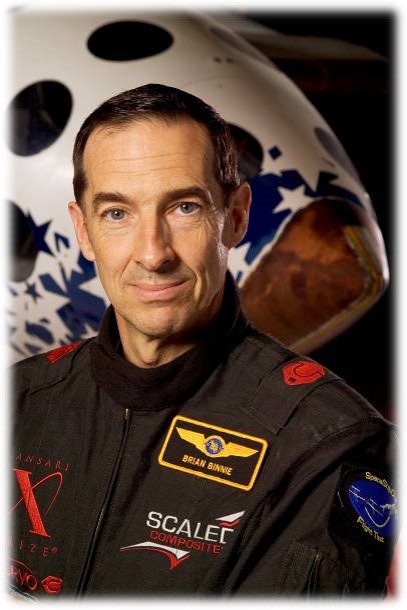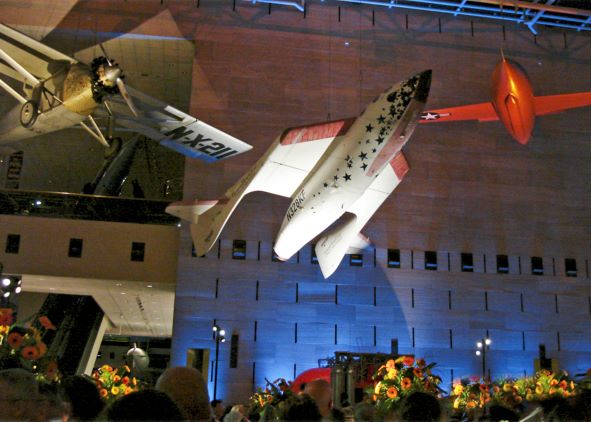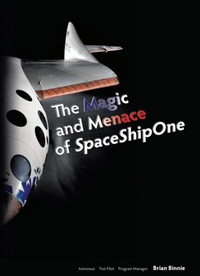Test pilot Brian Binnie recounts his historic flight on SpaceShipOne and the future of private space travel in new book
Binnie retells it all in "The Magic and Menace of SpaceShipOne."

Brian Binnie is a former United States Navy officer and test pilot for SpaceShipOne, the experimental space plane created by aeronautical pioneer, Burt Rutan, and his innovative company, Scaled Composites. SpaceShipOne was the product of a joint venture between entrepreneur Paul Allen and Scaled Composites.
On Oct. 4, 2004, SpaceShipOne was released from its White Knight mothership, and with Binnie at the controls, he made the second suborbital flight in one week's time to snag the $10 million Ansari X Prize flight purse. That pioneering passage of space and time marked a new era of commercial space flight.
Less than a year later, Sir Richard Branson and Rutan announced a joint venture between Virgin Galactic and Scaled Composites called The SpaceShip Company. Jointly, they would go on to build SpaceShipTwo, now being tested to haul paying passengers on suborbital sojourns from Spaceport America in New Mexico.
Binnie recently authored the engrossing book, "The Magic and Menace of SpaceShipOne" (Black Sky Enterprise, Oct. 4, 2020, available at: https://brianbinnie.net/ and at Amazon.)
"Spaceships are dangerous things. There are no intentions implied to suggest otherwise," Binnie writes, also noting his early copiloting experience in flying Rotary Rocket's Roton vehicle, built to be a single stage to orbit spaceship.
Space.com recently talked with Binnie about his forty years of what he tags as "wrestling with recalcitrant machinery" - flying vehicles that are doing their best to be lethal, but proving to be useful training.
Related: How SpaceShipOne and X Prize Launched Commercial Spaceflight
Get the Space.com Newsletter
Breaking space news, the latest updates on rocket launches, skywatching events and more!
The Magic and Menace of SpaceShipOne by Brian Binnie: $55 at Amazon.
Test pilot Brian Binnie shares what it was like to fly the first privately built reusable spacecraft, SpaceShipOne, to win the Ansari X Prize in 2004 and recalls his decades of flying.
Space.com: Your X Prize winning flight moved the needle forward on the prospect for public space travel. But here we are in 2021 and it has taken time for that promise to evolve. Why so long?
Binnie: From Virgin's perspective, Scaled Composite suffered two major accidents. In their wake, every anomaly or unexpected result was thoroughly scrutinized. Virgin really had no other option. With some 200 hundred astronaut founders already signed up after the X Prize flights, they needed the confidence that the ship was upright and not taking on water. I suppose it didn't help that expectations were always misaligned with real progress and the number of "this will be the year" could cloud everyone's judgment. I will say that under any other investor the program would likely have been cancelled. The fact that Branson presses on gives great credibility to their commitment of bringing space to the common man and woman. As they say, if it was easy ...
How involved were you in the decision-making about designing and then flying SpaceShipOne (SS1)?
Binnie: Pilots and engineers are closely joined at the hip. Engineers, however, can be like lawyers. They can keep a program in development for longer than it should, with "better being the enemy of good enough."
Burt Rutan had great judgment when looking at an issue or problem. His risk management skills, in my opinion, were rather extraordinary, and while others fretted, he would often suggest buttoning the vehicle up and go fly.
It remains in my mind a feat of such unlikely odds that in two-and-a-half years, the program developed and tested a mothership, rocket motor, avionics, simulator and a spaceship that went into that black sky on three of its six powered flights. And Burt was at the helm of all of it.
I believe the single most important attribute of Burt's was that in his mind he wasn't really building a spaceship, but rather another airplane that happened to have a rocket motor on it for part of the journey. Burt was very adverse to “bells and whistles” and that kept the program moving along. And since we didn’t handicap ourselves with detailed documentation of processes or paperwork, the team could make uncanny progress.
To your question, pilots come at the vehicle from the perspective of the cockpit. They want to know what can be affected, and by the same token, what cannot. From that standpoint, Burt was open to ideas and suggestions.

Space.com: If trouble arose in flying SS1, how could you get out?
Binnie: There were two choices. One of those was a little hatch door at your left side. The other was, if you got into trouble, you’d feather the vehicle, assuming the feather worked, and that puts it into stable attitude and pitch. Then you could unlatch the nose cone, push it away, unbuckle your seat and roll forward. Then you’re free and clear of the vehicle. I thought that was pretty novel thinking. All you have to worry about then is making sure the parachute works.
Space.com: After your winning X Prize flight, there seemed to be shop talk about more SS1 flights, pushing the envelope of the vehicle. Why didn’t that happen?
Binnie: Burt had set up a sensible plan for the vehicle. There were 21 tasks and the first 20 tasks involved getting to the X Prize flights. After that, he had task 21. He wanted to fly the vehicle, something like once a week for 20 weeks. In doing that, he could get a really good baseline on the operational costs of utilizing the vehicle. Perhaps along the way, you could make modifications to enhance the vehicle’s handling qualities and actually get more than one person in the cockpit. When the Smithsonian Air and Space Museum chimed in, more flights came screeching to a halt. Paul Allen didn’t want to risk the vehicle he had funded.
The last time I was there [at the museum], SS1 remained in-between the Bell X-1 and Spirit of St. Louis, but in its feathered configuration.
In Pictures: Breaking the Sound Barrier
Space.com: Back in 1999, you were one of the two person crew that flew Rotary Rocket's Atmospheric Test Vehicle (ATV), a unique craft using helicopter-style rotors for landing. What was that experience like?
Binnie: It was certainly a good experience and appealed to me. The Roton started out as an unmanned, small vehicle, but I joined when that concept was abandoned for a full-scaled manned demonstrator of a single stage to orbit design. Rotary did not lack for big dreams. My focus was on the cockpit and the flight controls, the simulator, and all the things that went into managing the propellant.
The other half of the company was designing a massive rotating engine with something like seventy six thrusters that would be spun up by centrifugal pumping of the propellants. You might say there were a lot of things spinning on that vehicle. But their effort was on building just one of these thrusters to be put on a whirl test stand. Alas, Rotary's money ran out before it was demonstrated.
The ATV ended up making three flights with five takeoffs and landings. The first flight was rather frightening and I was certainly quite happy to hand it back over to Gary Hudson, Rotary's CEO. But more money came in and two more flights were made with the last one having the vehicle fly down the runway at Mojave around seventy five feet and sixty knots. So we did what we said we were going to do… demonstrate control of the vehicle in the landing pattern.
Space.com: There's always talk about having space vehicles demonstrate "airline-like" operation. How far are we from that often-said saying?
Binnie: I've heard that line several times too. I'm thinking I don't see it. You look at the frequency of flight in general, manned or unmanned. They are onesie-twosies for the most part. Elon Musk is a kind of outlier in the business. I say good for him. Space is so demanding in terms of managing the power that’s required to get out of Earth’s gravity well. I don’t see any clever things that are going to change that. I keep waiting for the aliens to come back and show us how to do anti-gravity.
Photos: Amazing X-Planes from the X-1 to XV-15

Space.com: Speaking of Musk, he recently encountered static from the Federal Aviation Administration (FAA) about his Starship flight program. How’d the FAA treat the SS1 program?
Binnie: I have a couple chapters in the book about this. It was tortuous. We were the pathfinder for commercial reusable spaceships. As Elon said, the FAA has the wrong kind of people managing these programs, those that are used to big boosters that launch and never come back. They don’t have the mindset about reusable spaceships, whether they are suborbital or orbital. For SS1, the FAA just drove Burt completely nuts. There were sparks flying all the time. They came up with a set of whacky rules and Burt practically rejected all of them. When it was all said and done, the bureaucracy won. What they wanted is basically what they got. I think there’s a long ways to go in terms of having a relationship with the government that promotes this kind of activity. It just raises the bar of entry for most people that they can’t get in. I’d hate to see it intrude much with SpaceShipTwo.
Space.com: In putting you back in the pilot’s seat for that winning X Prize SS1 flight, was there anything surprising given all the training?
Binnie: Three days before I flew that flight, we completely changed the way we were going to fly the vehicle. So all the simulator work we had done for the past year was pretty much out the window. A new maneuver was invented, and we basically crossed our fingers and hoped it was good.
That flight – not my words – people called it the perfect flight. In leaving the atmosphere, as I kept the motor running to 215,000 feet, the ship had zero roll, pitch, yaw rates. It was rock solid and continued on up past the X-15 altitude, Burt’s grand plan. Wow…the fact that it all came together in that one flight. We certainly got a pretty good apogee out of it…nearly 70 miles up. The reentry was smooth as butter. It was just noisy. It was a wonderful experience. If you consider that through most of the SS1 program we had trials and difficulties, it all came together in that one flight, the final flight.
Space.com: Any other thoughts regarding your piloting of SS1?
Binnie: I’m a single-seat pilot kind of guy. I flew A7 Corsairs for 10 years in the Navy, and then transitioned to Hornets for another 10 years – all single-seat flying. SS1 was single-seat and that’s an environment in which I am comfortable with and like and have gotten used to. The experience for me going to space, I didn’t have to spoil it by having passengers or a co-pilot or whatever to kind of defocus my attention at things that I wanted to soak up.
Also being out at the Mojave Air and Space Port, you are really spoiled by the views. You had the Pacific, Los Angeles and Santa Barbara, the coast line, the Sierra Nevada mountains. You could see Edwards Air Force Base and all its history. That was all awesome to take in.
I don’t see any single-seat spaceships in the near-future. So maybe I am the last guy that has gone to space by himself.
Leonard David is author of the recently released book, “Moon Rush: The New Space Race” published by National Geographic in May 2019. A longtime writer for SPACE.com, David has been reporting on the space industry for more than five decades. Follow us @Space dotcom, Facebook or Google+. This version of the story published on Space.com.
Join our Space Forums to keep talking space on the latest missions, night sky and more! And if you have a news tip, correction or comment, let us know at: community@space.com.

Leonard David is an award-winning space journalist who has been reporting on space activities for more than 50 years. Currently writing as Space.com's Space Insider Columnist among his other projects, Leonard has authored numerous books on space exploration, Mars missions and more, with his latest being "Moon Rush: The New Space Race" published in 2019 by National Geographic. He also wrote "Mars: Our Future on the Red Planet" released in 2016 by National Geographic. Leonard has served as a correspondent for SpaceNews, Scientific American and Aerospace America for the AIAA. He has received many awards, including the first Ordway Award for Sustained Excellence in Spaceflight History in 2015 at the AAS Wernher von Braun Memorial Symposium. You can find out Leonard's latest project at his website and on Twitter.










